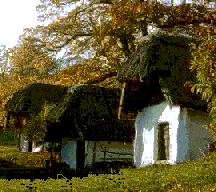 The
Slavs came to Europe together with Germanic and Baltic tribes, and then
they, obviously, spoke one language and were just beginning to break up
to several dialects. The Slavic tribes lived first in the region of the
Bug, Pripyat, Dvina rivers. Then, as tribes were continuously growing,
they spread to the territories of Modern Poland, occupied all forest-steppe
region of Middle Russia and began slow migration to the north and north-east,
contacting there with Finnish hunters.
The
Slavs came to Europe together with Germanic and Baltic tribes, and then
they, obviously, spoke one language and were just beginning to break up
to several dialects. The Slavic tribes lived first in the region of the
Bug, Pripyat, Dvina rivers. Then, as tribes were continuously growing,
they spread to the territories of Modern Poland, occupied all forest-steppe
region of Middle Russia and began slow migration to the north and north-east,
contacting there with Finnish hunters.
Balto-Slavic language community is believed to be the last to break into two single branches, that's why Baltic and Slavic languages are even now very similar to each other (e.g. Lithuanian and Belorussian). The Common Slavic tongue also preserved much of his structure from Proto-Indo-European, plenty of words also kept their archaic meanings.
The phonetics of Common Slavic included several interesting features. It had not only short and long vowels, but also super-short ones, called "u-jer" and "i-jer", derived from Proto-Indo-European short u and i respectively. These sounds are used nowadays in some modern Slavic languages - in Russian, Ukrainian, etc. One vowel sound is unique in Common Slavic and cannot be reflected in English - this is a back "ee", roughly. It exists still in Russian and many other Slavic languages and is usually marked as [y]. Diphthongs tended to disappear in Common Slavic, being changed by single vowels; the group "vowel + nasal consonant" gave one of the special nasal vowels - o or e. Slavic consonants lost aspirants, palatals turned into sibilants ([sj] > [š] etc.). Slavic phonetics is enormously rich with vowel and consonant interchanges, and Russian children still cry at school trying to remember all them (believe me).
Slavic language had seven cases, three genders and three numbers. Practically all the flexions can be observed from the Proto-Indo-European, and phonetic laws work here quite well. There was no non-Indo-European influence, that's why no analytization or loss of endings took place in this Common Slavic epoch. The ablative case of nouns was assimilated by the genitive. Adjectives are declined just like nouns, and have also pronominal forms for emphasizing. Numerals can also be declined, and in a different way (1 - like an adjective in singluar, 2 - in dual, 3 - in plural, 4 - like a noun of r-stems, 5 - like a noun of i-stems). Among pronouns we can name personal, possessive, reflexive, demonstrative (2 or 3 grades), anaphoric, interrogative. All of them are declinable.
The verb possesses present, imperfect, aorist and perfect tenses. Future is formed with present endings, differing only in meaning, but not in form. Some linguists supose there was also plusquamperfect, but I think it was developed on the basis of perfect later in Old Church Slavic. The subjunctive disappeared, forming since then with a particle by + past forms. There was an infinitive in -ti and the supine in -tu. Later the last vowels of these two forms turned into super-short. Four or even six different participles finish the survey.
In the 2rd century BC the Slavic community begins to disappear. The
Slavs start long migrations over Eastern Europe. They come to what is now
Moscow region, pushing back Finnish tribes, they occupy modern Chech, Slovak,
Eastern German lands. In the beginning of the new era they conquer southern
regions: Balkans, Pannonia, Macedonia, Illyria. They invade Bizantia and
Greece. It was the starting point of the creation of three different Slavic
groups: Eastern, Western, Southern.